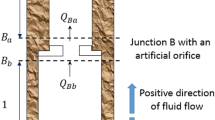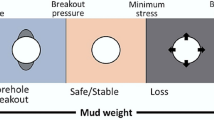Abstract
Depressurization gives rise to complex sediment–well interactions that may cause the failure of wells. The situation is aggravated when high depressurization is imposed on sediments subjected to an initially low effective stress, such as in gas production from hydrate accumulations in marine sediments. Sediment–well interaction is examined using a nonlinear finite element simulator. The hydro-mechanically coupled model represents the sediment as a Cam-Clay material, uses a continuous function to capture compressibility from low to high effective stress, and recognizes the dependency of hydraulic conductivity on void ratio. Results highlight the critical effect of hydro-mechanical coupling as compared to constant permeability models: A compact sediment shell develops against the screen, the depressurization zone is significantly smaller than the volume anticipated assuming constant permeability, settlement decreases, and the axial load on the well decreases; in the case of hydrates, gas production will be a small fraction of the mass estimated using a constant permeability model. High compressive axial forces develop in the casing within the production horizon, and the peak force can exceed the yield capacity of the casing and cause its collapse. Also tensile axial forces may develop in the casing above the production horizon as the sediment compacts in the depressurized zone and pulls down from the well. Well engineering should consider: slip joints to accommodate extensional displacement above the production zone, soft telescopic/sliding screen design to minimize the buildup of compressive axial force within the production horizon, and enlarged gravel pack to extend the size of the depressurized zone.








Similar content being viewed by others
References
Anderson BJ, Kurihara M, White MD, Moridis GJ, Wilson SJ, Pooladi-Darvish M, Gaddipati M, Masuda Y, Collett TS, Hunter RB, Narita H, Rose K, Boswell R (2010) Regional long-term production modeling from a single well test, Mount Elbert gas hydrate stratigraphic test well, Alaska North slope. Mar Pet Geol 28(2):493–501
Carrier WD (2003) Goodbye Hazen; Hello Kozeny-Carman. J Geotech Geoenviron Eng ASCE 129(GT 11):1054–1056
Chapuis RP (2012) Predicting the saturated hydraulic conductivity of soils: a review. B Eng Geol Environ 71(3):401–434
Chong SH, Santamarina JC (2016) Soil Compressibility Models for Wide Stress Range. J Geotech Geoenviron Eng ASCE (Published on line 3/2016)
Cook AE, Malinverno A (2013) Short migration of methane into a gas hydrate-bearing sand layer at Walker Ridge. Geochem Geophys Geosyst 14:283–291. doi:10.1002/ggge.20040
Dolinar B (2009) Predicting the hydraulic conductivity of saturated clays using plasticity-value correlation. Appl Clay Sci 45:90–94
Feia S, Sulem J, Canou J, Ghabezloo S, Clain X (2016) Changes in permeability of sand during triaxial loading: effect of fine particles production. Acta Geotech 11:1–19
Gamwo IK, Liu Y (2010) Mathematical modeling and numerical simulation of methane production in a hydrate reservoir. Ind Eng Chem Res 49:5231–5245
Gens A, Potts DM (1988) Critical state models in computational geomechanics. Eng Comput 8(3):178–197
Hong H, Pooladi-Darvish M (2003) A numerical study on gas production from formations containing gas hydrates. In: Canadian international petroleum conference-54th Annual technical meeting, June 10–12, Calgary, Canada
Klar A, Uchida S, Soga K, Yamamoto K (2013) Explicitly coupled thermal flow mechanical formulation for gas-hydrate sediments. SPE J 18(02):196–206
Kurihara M, Sato A, Ouchi H, Narita H, Masuda Y, Saeki T, Fujii T (2009) Prediction of gas productivity from eastern Nankai Trough methane hydrate reservoirs. SPE J Reserv Eval Eng 12:477–499
Kwon TH, Cho GC, Santamarina JC (2007) Hydrate dissociation in sediments: pressure-temperature evolution. Geochem Geophys Geosyst 9(2):Q03019. doi:10.1029/2007GC001920
Lee C, Yun TS, Lee JS, Bahk JJ, Santamarina JC (2011) Geotechnical characterization of marine sediments in The Ulleung Basin, East Sea. Eng Geol 117:151–158
Mesri G, Olson RE (1971) Mechanisms controlling the permeability of clays. Clay Clay Miner 19:151–158
Moridis GJ, Collett TS, Boswell R, Kurihara M, Reagan MT, Koh C, Sloan ED (2009) Toward production from gas hydrates: assessment of resources, technology, and potential. SPE Journal 12(5):745–771. doi:10.2118/114163
Moridis GJ, Collett TS, Pooladi-Darvish M, Pooladi-Darvish M, Santamarina C, Boswell R, Kneafsey TJ, Rutqvist J, Reagan MT, Sloan ED, Sum A, Koh C (2011) Challenges, uncertainties, and issues facing gas production from gas-hydrate deposits. SPE Res Eval Eng 14(1):76–112. doi:10.2118/131792-PA
Moridis GJ, Sloan ED (2007) Gas production potential of disperse low-saturation hydrate accumulations in oceanic sediments. Energy Convers Manag 48:1834–1849
Moridis GJ, Kowalsky MB, Pruess K (2007) Depressurization-induced gas production from class 1 hydrate deposits. SPE J Reser Eval Eng 10:458–481
Moridis GJ, Silpngarmlert S, Reagan MT, Collett T, Zhang K (2010) Gas production from a cold, stratigraphically-bounded gas hydrate deposit. Mar Pet Geol. doi:10.1016/j.marpetgeo.2010.01.005
Muir Wood D (1990) Soil behaviour and critical state soil mechanics. Cambridge University Press, Cambridge
Nazridoust K, Ahmadi G (2007) Computational modeling of methane hydrate dissociation in a sandstone core. Chem Eng Sci 62:6155–6177
Poulos HG, Davis EH (1980) Pile foundation analysis and design. Wiley, Hoboken
Raju IS, Rao BP, Venkataramana J (1974) A conical shell finite element. Comput Struct 4:901–915
Ren X-W, Santamarina JC (2006) The hydraulic conductivity in sediments. ASCE Geotech J (Under review)
Samarasinghe AM, Huang YH, Drnevich VP (1982) Permeability and consolidation of normally consolidated soils. J Geotech Eng Div 108(GT6):835–850
Sánchez M, Shastri A, Santamarina JC, Gai X (2014) Coupled modeling of gas hydrate bearing sediments. In: 14th International conference of the international association for computer methods and advances in geomechanics, 14th IACMAG. Kyoto
Schofield AN (1980) Cambridge University geotechnical centrifuge operations. Getech 30(3):227–268
Segura JM, Carol I (2004) On zero-thickness interface elements for diffusion problems. Int J Numer Anal Meth Geomech 28(9):947–962
Simo JC, Taylor RL (1985) Consistent tangent operators for rate-independent elastoplasticity. Comput Methods Appl Mech Eng 48:101–118
Sloan ED, Koh CA (2008) Clathrate hydrates of natural gases, 3rd edn. CRC Press, Boca Raton
Uddin M, Coombe D, Law D, Gunter B (2008) Numerical studies of gas hydrate formation and decomposition in a geological reservoir. J Energy Res Technol 130:032501
Wilder JW, Moridis GJ, Wilson SJ, Kurihara M, White MD, Masuda Y, Anderson BJ., Collett TS, Hunter RB, Narita H, Pooladi-Darvish M, Rose K, Boswell R (2008) An international effort to compare gas hydrate reservoir simulators. In: Proceedings of the 6th international conference on gas hydrate, July 6–10 Vancouver, Canada
Yu HS (2006) Plasticity and geotechnics. Springer, New York
Yun TS, Lee C, Lee JS, Bahk JJ, Santamarina JC (2011) A pressure core based characterization of hydrate bearing sediments in the Ulleung Basin East Sea. J. Geophys. Res. 117:151–158. doi:10.1029/2010JB007468
Acknowledgments
Support for this research was provided by the USA Department of Energy, the Korean Institute of Geoscience and Mineral Resources KIGAM, and the KAUST endowment. We are grateful to Dr. GC Cho (KAIST) and Dr. JY Lee (KIGAM) and two anonymous reviewers for thoughtful discussions and insight.
Author information
Authors and Affiliations
Corresponding author
Rights and permissions
About this article
Cite this article
Shin, H., Santamarina, J.C. Sediment–well interaction during depressurization. Acta Geotech. 12, 883–895 (2017). https://doi.org/10.1007/s11440-016-0493-1
Received:
Accepted:
Published:
Issue Date:
DOI: https://doi.org/10.1007/s11440-016-0493-1




